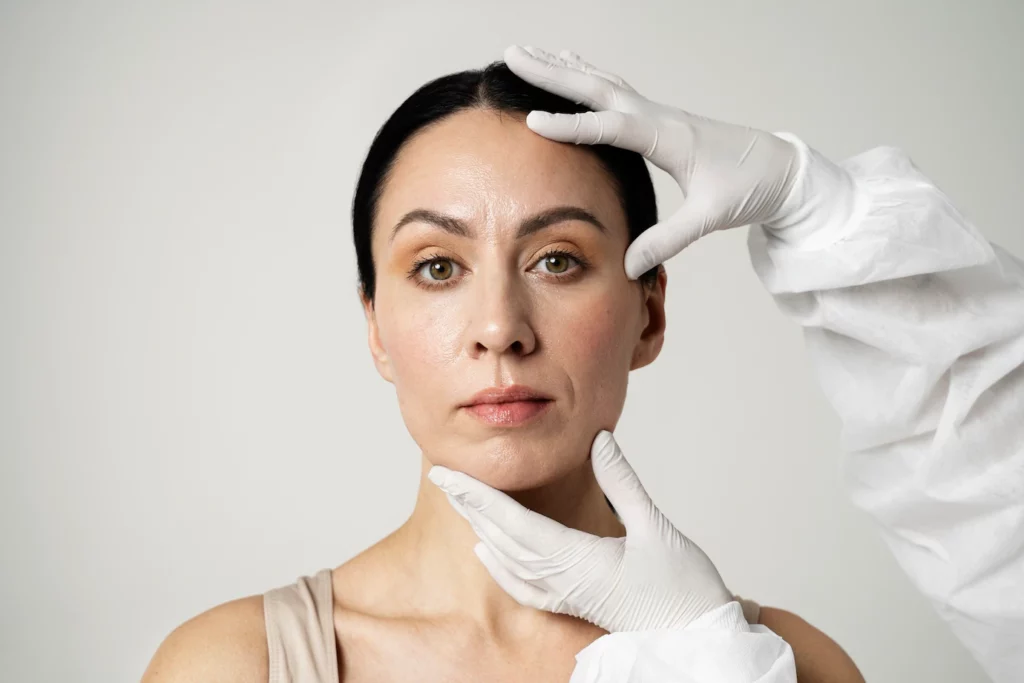Looking Facial Feminization Surgery Costs? Facial feminization surgery (FFS) is a set of cosmetic procedures that aim to modify the facial features of transgender women and cisgender women who feel that their faces are too masculine. FFS can help create a more feminine and harmonious appearance, as well as improve the psychological well-being and quality of life of the patients1
In this article, we will explain what FFS is, what procedures it involves, what results you can expect, and how to prepare for it. We will also answer some frequently asked questions about FFS and compare the costs of FFS by country.
Table of Contents
What is FFS?
FFS is a term that encompasses various surgical techniques that alter the shape and size of the facial bones and soft tissues to make them more feminine. FFS can include procedures such as:
- Hairline correction: This involves lowering and rounding the hairline, either by advancing the scalp or transplanting hair follicles2
- Forehead recontouring: This involves reducing the prominence of the brow ridge and the supraorbital rims (the bony edges above the eyes), as well as smoothing and flattening the forehead2
- Brow lift: This involves raising the eyebrows to a higher and more arched position, creating a more open and expressive look2
- Eye and lid modification: This involves reshaping the eyelids to create a more almond-shaped and feminine appearance, as well as removing excess skin and fat from the upper and lower eyelids2
- Cheek augmentation: This involves enhancing the volume and projection of the cheeks, either by using implants, fat grafting, or fillers2
- Nose reshaping (rhinoplasty): This involves changing the size, shape, and angle of the nose to make it more proportionate and refined2
- Lip lift and augmentation: This involves shortening the distance between the nose and the upper lip, as well as increasing the fullness and curvature of the lips2
- Jaw angle reduction: This involves narrowing and tapering the jawline, as well as reducing the angle and width of the jaw at the back of the face2
- Chin width reduction: This involves reducing the horizontal width of the chin, as well as reshaping it to make it more pointed and feminine2
- Adam’s apple reduction (tracheal shave): This involves shaving off the excess cartilage from the thyroid cartilage (the prominent part of the voice box) to create a smoother and less visible neck contour2
FFS can be performed in one or multiple stages, depending on the patient’s goals, preferences, and budget. The duration of each surgery can vary from two to eight hours, depending on the number and complexity of the procedures3

Why do people choose FFS?
FFS is not a mandatory or essential part of gender transition for transgender women, but many choose to undergo it for various reasons. Some of these reasons are:
- To reduce gender dysphoria: Gender dysphoria is a condition where a person feels distress or discomfort due to a mismatch between their gender identity and their assigned sex at birth. For some transgender women, having masculine facial features can cause them to feel unhappy, anxious, depressed, or suicidal. FFS can help them align their physical appearance with their gender identity, thus alleviating their dysphoria.
- To improve social integration: Having a feminine face can help transgender women pass as cisgender women in society, which can reduce discrimination, harassment, violence, and stigma that they may face otherwise. FFS can also help them gain acceptance from their family, friends, co-workers, and romantic partners.
- To enhance self-esteem: Having a feminine face can also boost the confidence and self-esteem of transgender women, as they can feel more attractive, comfortable, and authentic in their own skin. FFS can also improve their body image and sexual satisfaction.
FFS is not only for transgender women, but also for cisgender women who are unhappy with their facial features due to genetic or hormonal factors. Some cisgender women may have facial features that are perceived as masculine or unattractive by themselves or others, such as a prominent brow ridge, a large nose, a square jaw, or a receding hairline. FFS can help them achieve a more feminine and balanced facial appearance that matches their desired aesthetic.

What are the benefits of FFS?
FFS can have many benefits for both transgender and cisgender women who undergo it. Some of these benefits are:
- Improved appearance: FFS can create a more feminine and harmonious facial appearance by modifying the facial features that are most influenced by sex hormones during puberty. FFS can also correct any asymmetries, deformities, or aging signs that may affect the facial appearance.
- Improved function: FFS can also improve the function of some facial structures, such as the nose, the eyelids, and the lips. For example, rhinoplasty can improve the breathing and sense of smell, blepharoplasty can improve the vision and eye health, and lip lift and augmentation can improve the speech and oral hygiene.
- Improved quality of life: FFS can have a positive impact on the psychological and social well-being of the patients, as they can feel more comfortable and happy with their appearance, identity, and expression. FFS can also reduce the stress and anxiety that may come from living with a face that does not match their gender or expectations. FFS can also increase the opportunities and choices that the patients have in their personal and professional lives.
What are the risks of FFS?
Like any other type of major surgery, FFS carries some risks and complications that the patients should be aware of before undergoing it. Some of these risks are:
- Bleeding: There is a risk of bleeding during or after the surgery, which may require blood transfusion or additional surgery to stop it.
- Infection: There is a risk of infection at the surgical site or in the bloodstream, which may require antibiotics or additional surgery to treat it.
- Damage to nearby structures: There is a risk of damage to nearby nerves, muscles, blood vessels, or organs during the surgery, which may cause temporary or permanent loss of sensation, movement, function, or appearance.
- Imbalance in facial features: There is a risk of imbalance or asymmetry in the facial features after the surgery, which may require additional surgery to correct it.
- Visible scarring: There is a risk of visible scarring on the face or scalp after the surgery, which may require additional treatments to improve it.
- Fluid accumulation: There is a risk of fluid accumulation under the skin after the surgery, which may require drainage or additional surgery to remove it.
- Hematoma: There is a risk of hematoma (a solid swelling of clotted blood) within the tissues after the surgery, which may require drainage or additional surgery to remove it.
- Dissatisfaction with appearance: There is a risk of dissatisfaction with the appearance after the surgery, either due to unrealistic expectations, poor communication, technical errors, or complications.

How to prepare for FFS?
FFS is a major decision that requires careful planning and preparation. The patients should do their research and consult with qualified and experienced surgeons who specialize in FFS. The patients should also have realistic expectations and clear goals about what they want to achieve with FFS.
Before FFS, the patients will need to undergo a comprehensive evaluation that includes:
- A medical history review: The surgeon will ask about any medical conditions, medications, allergies, previous surgeries, or family history that may affect the surgery or recovery.
- A physical examination: The surgeon will examine the face and its features, as well as measure the facial dimensions and proportions. The surgeon will also take photographs and X-rays of the face for planning purposes.
- A psychological assessment: The surgeon will assess the mental health and emotional stability of the patients, as well as their motivation and readiness for FFS. The surgeon will also discuss the potential benefits and risks of FFS with them.
The patients will also need to follow some instructions before FFS, such as:
- Quitting smoking: Smoking can impair wound healing and increase the risk of infection and scarring after FFS. The patients should quit smoking at least four weeks before and after FFS.
- Avoiding certain medications: Some medications can increase the risk of bleeding or interfere with anesthesia during FFS. The patients should avoid taking aspirin, ibuprofen, warfarin, herbal supplements, or any other blood-thinning medications for at least two weeks before FFS. The patients should also consult with their surgeon about any prescription medications that they are taking.
- Eating and drinking: The patients should not eat or drink anything for at least eight hours before FFS. They should also avoid alcohol for at least 24 hours before FFS.
- Arranging transportation and assistance: The patients will need someone to drive them home and stay with them for at least 24 hours after FFS. They will also need someone to help them with daily activities for at least one week after FFS.

What to expect during FFS?
FFS is usually performed under general anesthesia in a hospital or an accredited surgical facility. Depending on the number and type of procedures involved, FFS can take from two to eight hours, depending on the number and complexity of the procedures.
During FFS, the surgeon will make incisions in strategic locations to access the facial bones and soft tissues. The surgeon will then use various instruments and techniques to reshape, reposition, or remove the facial structures that need to be modified. The surgeon will also close the incisions with sutures, staples, or glue, and apply bandages and dressings to protect the wounds. The surgeon may also insert drains or tubes to remove excess blood or fluid from the surgical site.
The patients will be monitored in a recovery room for a few hours after FFS, where they will receive pain medication and antibiotics. The patients may also experience some swelling, bruising, numbness, or discomfort in their face, which will gradually subside over time. The patients will be discharged from the hospital once they are stable and able to eat and drink normally.

What to expect after FFS?
FFS is a major surgery that requires a significant recovery period. The patients will need to follow some instructions after FFS, such as:
- Taking care of the wounds: The patients will need to keep the wounds clean and dry, and change the bandages and dressings as instructed by the surgeon. The patients will also need to avoid touching, scratching, or picking at the wounds, as this can cause infection or scarring. The patients will also need to avoid exposing the wounds to direct sunlight, heat, or cold, as this can affect the healing process. The patients will also need to visit the surgeon regularly for wound check-ups and suture removal.
- Taking medication: The patients will need to take pain medication, antibiotics, anti-inflammatory drugs, or any other medication prescribed by the surgeon. The patients will also need to avoid taking any medication that can interfere with blood clotting or healing, such as aspirin, ibuprofen, warfarin, herbal supplements, or alcohol. The patients will also need to consult with their surgeon before taking any hormone therapy or other medication that can affect their facial appearance.
- Resting and recovering: The patients will need to rest and recover for at least two weeks after FFS, and avoid any strenuous activity or exercise that can increase blood pressure or swelling. The patients will also need to sleep with their head elevated on pillows to reduce swelling and discomfort. The patients will also need to avoid smoking, chewing gum, blowing their nose, wearing glasses, or applying makeup for at least four weeks after FFS. The patients will also need to eat soft foods and drink plenty of fluids for at least one week after FFS.
- Managing expectations: The patients will need to be patient and realistic about the results of FFS, as they may not be visible immediately after the surgery. The patients may experience some swelling, bruising, numbness, tightness, or asymmetry in their face for several weeks or months after FFS, which will gradually improve over time. The patients may also notice some changes in their facial expressions or sensations due to nerve damage or regeneration. The patients may also require some minor revisions or touch-ups to achieve their desired outcome.
How much does FFS cost?
FFS is a highly customized and individualized surgery that can vary in cost depending on several factors, such as:
- The number and type of procedures involved: FFS can include multiple procedures that can affect different parts of the face, such as the hairline, forehead, brows, eyes, nose, cheeks, lips, jaw, chin, and Adam’s apple. Each procedure has its own cost and complexity that can add up to the total cost of FFS.
- The surgeon’s experience and reputation: FFS is a complex and delicate surgery that requires a high level of skill and expertise from the surgeon. A more experienced and reputable surgeon may charge more for their services than a less experienced or qualified one.
- The location and facility of the surgery: FFS can be performed in different countries and facilities that have different standards of quality and safety. A more developed and regulated country or facility may charge more for their services than a less developed or regulated one.
- The anesthesia and hospital fees: FFS is usually performed under general anesthesia in a hospital or an accredited surgical facility. The anesthesia and hospital fees can vary depending on the duration of the surgery and the level of care provided.
- The post-operative care and follow-up: FFS requires a significant recovery period that involves wound care, medication, visits to the surgeon, and possible revisions or touch-ups. The post-operative care and follow-up fees can vary depending on the extent of the surgery and the complications that may arise.
According to some estimates, the average cost of FFS in different countries is as follows:
- USA: $20,000 – $60,000
- Turkey: $10,000 – $25,000
- Korea: $15,000 – $35,000
- Thailand: $12,000 – $30,000
These estimates are only approximate and may not reflect the actual cost of FFS for each patient. The patients should consult with their surgeon and obtain a detailed quote that includes all the fees and expenses involved in FFS.
How to compare FFS costs by country?
FFS is a major investment that can have a significant impact on the appearance, identity, and quality of life of the patients. Therefore, the patients should compare FFS costs by country carefully and consider various factors before making a decision, such as:
- The quality and safety of the surgery: The patients should research the qualifications and credentials of the surgeon and the facility where they plan to have FFS. The patients should also check the reviews and testimonials of previous patients who have had FFS with the same surgeon or facility. The patients should also ask for before and after photos and videos of FFS cases that are similar to theirs. The patients should also inquire about the risks and complications of FFS and how they are handled by the surgeon or facility.
- The travel and accommodation expenses: The patients should calculate the travel and accommodation expenses that they will incur if they choose to have FFS in another country. The patients should also consider the visa requirements, currency exchange rates, transportation options, and cultural differences that may affect their travel and stay. The patients should also factor in the time and cost of traveling back to their home country for follow-up visits or revisions.
- The personal preferences and goals: The patients should also consider their personal preferences and goals when comparing FFS costs by country. The patients should choose a country and a surgeon that can meet their expectations and deliver their desired results. The patients should also choose a country and a surgeon that they feel comfortable and confident with.
FFS is a life-changing surgery that can help transgender and cisgender women achieve a more feminine and harmonious facial appearance. FFS can also improve their psychological and social well-being and quality of life. However, FFS is also a complex and expensive surgery that requires careful planning and preparation. The patients should do their research and consult with qualified and experienced surgeons who specialize in FFS. The patients should also have realistic expectations and clear goals about what they want to achieve with FFS. The patients should also compare FFS costs by country and consider various factors before making a decision.
Frequently Asked Questions about FFS
Here are some common questions that people may have about FFS:
- Q: Is FFS covered by insurance?
- A: FFS is usually considered an elective or cosmetic surgery that is not covered by most insurance plans. However, some insurance plans may cover some or all of the costs of FFS if it is deemed medically necessary or beneficial for the patient’s health or well-being. The patients should check with their insurance provider and their surgeon to find out if they are eligible for any coverage or reimbursement for FFS.
- Q: How long does it take to recover from FFS?
- A: The recovery time from FFS can vary depending on the number and type of procedures involved, as well as the individual healing process of each patient. In general, it may take from two to six weeks for the swelling, bruising, numbness, and discomfort to subside after FFS. It may take from six months to one year for the final results of FFS to be visible and stable.
- Q: How painful is FFS?
- A: FFS is usually performed under general anesthesia, which means that the patient will not feel any pain during the surgery. After the surgery, the patient may experience some mild to moderate pain in their face, which can be managed with pain medication prescribed by the surgeon. The pain will gradually decrease as the wounds heal and the swelling goes down.
- Q: How long does FFS last?
- A: FFS is designed to create permanent changes in the facial features that will not revert back to their original state. However, some factors may affect the longevity of FFS results, such as aging, weight fluctuations, hormonal changes, sun exposure, smoking, or trauma. Therefore, the patient may need some maintenance or enhancement procedures in the future to preserve or improve their facial appearance.
- Q: Can I have other surgeries with FFS?
- A: Yes, it is possible to combine other surgeries with FFS, such as breast augmentation, body contouring, genital reconstruction, or voice feminization. However, this may increase the duration, complexity, cost, risk, and recovery time of the surgery. Therefore, the patient should consult with their surgeon about the pros and cons of having multiple surgeries at once.

